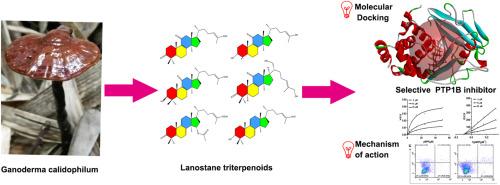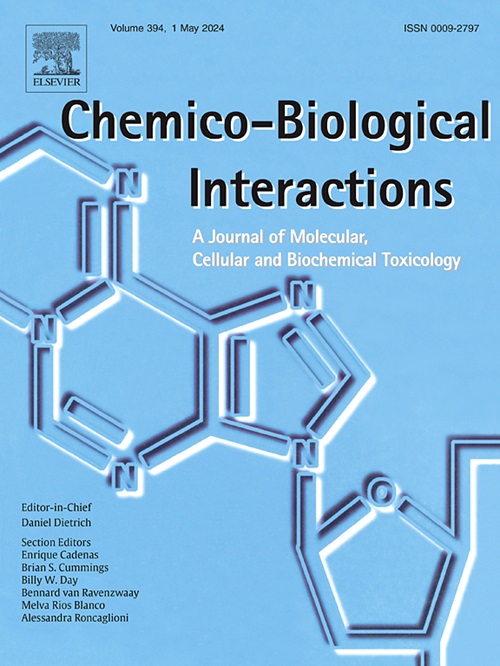Lanostane triterpenoids from Ganoderma calidophilum exhibit potent anti-tumor activity by inhibiting PTP1B
IF 4.7
2区 医学
Q1 BIOCHEMISTRY & MOLECULAR BIOLOGY
引用次数: 0
Abstract
The species Ganoderma calidophilum represents a distinct variety within the genus Ganoderma and used by the indigenous Li ethnic group as a medicinal agent for the prevention and treatment of cancer. However, the precise biological activity and role of G. calidophilum in antitumor treatment remain largely unresolved. Several lanostane triterpenoids have been isolated from G. calidophilum. The enzyme activity analysis revealed that four lanostane triterpenoids exhibited PTP1B inhibition activity, with minimal inhibition towards SHP2, SHP1, PTPN5, PTPRA, STEP and TCPTP. Molecular docking analysis demonstrated that these compounds primarily bind to the substrate recognition and entry regions of PTP1B. Further analysis indicated that among them, ganoderic aldehyde A (GAA) is a selective and non-competitive PTP1B inhibitor. GAA inhibited the proliferation, colony formation and migration of C33A and MDA-MB-231 cells in a dose-dependent manner. GAA has the capacity to induce apoptosis in a cell-type-specific manner, both in a caspase-dependent and -independent manner. PTP1B siRNA significantly reduced the cytotoxic effect of GAA, while overexpression of PTP1B significantly increased cell growth after GAA treatment. These findings confirm that PTP1B is a functional target of GAA. Research into the mechanisms of action of GAA has revealed that it could inhibit the activation of AKT by inhibiting PTP1B, while simultaneously activating p38, which promotes cell death. It is possible to develop specific PTP1B inhibitors based on the lanosterol triterpene skeleton. G. calidophilum has the potential to be developed into functional foods or drugs with the aim of preventing and treating cancer.

灵芝三萜类化合物通过抑制 PTP1B 显示出强大的抗肿瘤活性。
嗜热灵芝(Ganoderma calidophilum)是灵芝属中的一个独特品种,被黎族土著用作预防和治疗癌症的药剂。然而,嗜热灵芝在抗肿瘤治疗中的确切生物活性和作用在很大程度上仍未得到解决。从 G. calidophilum 中分离出了几种羊毛甾烷三萜类化合物。酶活性分析表明,四种羊毛甾三萜类化合物具有 PTP1B 抑制活性,对 SHP2、SHP1、PTPN5、PTPRA、STEP 和 TCPTP 的抑制作用极小。分子对接分析表明,这些化合物主要与 PTP1B 的底物识别区和进入区结合。进一步的分析表明,其中甘露醛 A(GAA)是一种选择性和非竞争性的 PTP1B 抑制剂。GAA 能以剂量依赖性方式抑制 C33A 和 MDA-MB-231 细胞的增殖、集落形成和迁移。GAA 能以细胞类型特异性的方式诱导细胞凋亡,包括依赖和不依赖 Caspase 的方式。PTP1B siRNA 能显著降低 GAA 的细胞毒性作用,而过表达 PTP1B 能显著增加 GAA 处理后的细胞生长。这些发现证实了 PTP1B 是 GAA 的功能靶点。对 GAA 作用机制的研究发现,它可以通过抑制 PTP1B 来抑制 AKT 的活化,同时激活 p38,从而促进细胞死亡。根据羊毛甾醇三萜骨架开发特异性 PTP1B 抑制剂是有可能的。嗜热蟹有可能被开发成功能性食品或药物,以达到预防和治疗癌症的目的。
本文章由计算机程序翻译,如有差异,请以英文原文为准。
求助全文
约1分钟内获得全文
求助全文
来源期刊
CiteScore
7.70
自引率
3.90%
发文量
410
审稿时长
36 days
期刊介绍:
Chemico-Biological Interactions publishes research reports and review articles that examine the molecular, cellular, and/or biochemical basis of toxicologically relevant outcomes. Special emphasis is placed on toxicological mechanisms associated with interactions between chemicals and biological systems. Outcomes may include all traditional endpoints caused by synthetic or naturally occurring chemicals, both in vivo and in vitro. Endpoints of interest include, but are not limited to carcinogenesis, mutagenesis, respiratory toxicology, neurotoxicology, reproductive and developmental toxicology, and immunotoxicology.

 求助内容:
求助内容: 应助结果提醒方式:
应助结果提醒方式:


